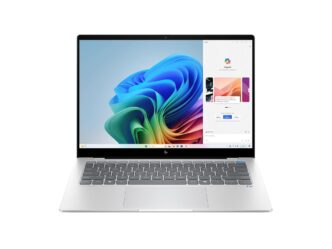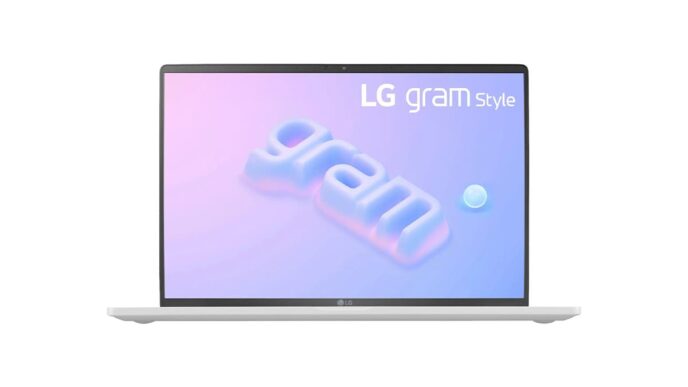The HP OmniBook X 14 is one of the first wave of Windows Copilot+ PCs, built around Qualcomm’s Snapdragon X Elite platform to deliver long battery life, on‑device AI via a dedicated NPU, and quiet, efficient performance in a slim 14‑inch chassis. HP’s configuration pairs a 2.2K touch display, a 5MP Windows Hello webcam, USB‑A plus dual USB‑C, Wi‑Fi 7, and quick access to Copilot, all in a lightweight design. This review breaks down real‑world performance, battery life versus claims, thermals and noise, app/game compatibility on Arm, Copilot+ NPU use cases, connectivity and ecosystem behavior, display comfort, and long‑term considerations including repairability and longevity.
In this HP OmniBook X Laptop Review, we’ll take a look at:
At‑a‑glance: What is the HP OmniBook X?
- The HP OmniBook X 14 is a Copilot+ PC powered by Qualcomm’s Snapdragon X Elite SoC with a high‑performance NPU designed to run AI features locally while delivering all‑day battery life.
- HP equips it with a 14‑inch 2.2K (2240×1400) IPS touchscreen, a 5MP IR webcam, Poly Studio‑tuned audio, and a slim chassis under 1.35kg, with Wi‑Fi 7 and a mix of USB‑C and USB‑A ports.
- It targets portable productivity with efficient CPU performance and strong battery claims, while integrated Adreno graphics prioritize efficiency over high‑end gaming power.
Design, Build, and Portability
HP opts for a clean, minimalist metal design with a reflective HP logo, emphasizing a sturdy but featherweight build just under 3lb and a thin profile, making it easy to slip into a backpack for travel or commuting. Recycled materials—aluminum and plastics including ocean‑bound plastic—feature in the construction, reflecting HP’s sustainability push. The keyboard and touchpad are described as comfortable and responsive, and HP includes a dedicated Copilot key for instant access to Microsoft’s AI assistant in Windows 11. For those who value portability without sacrificing a tactile typing experience, this design hits the right notes at its price class.
HP OmniBook X specs and configuration
- Processor: Snapdragon X Elite (e.g., X1E‑78‑100, 12 cores, up to 3.4GHz).
- Graphics: Integrated Qualcomm Adreno GPU.
- Memory: Up to 32GB LPDDR5x‑8448 (onboard).
- Storage: Up to 1TB PCIe Gen4 NVMe M.2 SSD.
- Display: 14‑inch 2.2K (2240×1400) IPS touchscreen, 100%sRGB, 400nits, Low Blue Light, Eyesafe Certified, Gorilla Glass NBT.
- Camera: 5MP IR webcam with Windows Hello and Windows Studio Effects.
- Audio: Dual speakers with Poly Studio tuning; HP Audio Boost.
- Wireless: Wi‑Fi 7 (Qualcomm FastConnect 7800) and Bluetooth 5.4.
- Ports: 2×USB‑C (10Gbps, DP1.4a, PD), 1×USB‑A (10Gbps), 3.5mm headset.
- Battery: 59Wh; fast charge to ~50% in 30 minutes.
- Weight: Around 1.34kg; thin and compact footprint.
These details align the laptop squarely with other ultra‑portables, but the bold value proposition is its Arm platform and on‑device AI acceleration.
Performance: CPU, GPU, and day‑to‑day speed
Everyday responsiveness is snappy, with the Snapdragon X Elite delivering competitive performance versus recent Intel Core Ultra and AMD Ryzen chips in common productivity and media editing tasks, while also challenging Apple’s fan‑favorite ultraportables in some synthetic CPU tests. Reviewers emphasize that, while CPU throughput and system fluidity are solid, the integrated Adreno GPU isn’t meant for heavy gaming and tends to lag behind x86 laptops with stronger iGPUs or discrete graphics solutions in synthetic tests and real game workloads. For office work, web apps, conferencing, Photoshop‑lite edits, and light creative workloads, the performance profile is compelling; for 3D gaming or GPU‑bound creative work, expectations need to be tempered.
- HP’s own guidance highlights the OmniBook X keeping pace with higher‑end Snapdragon chips and handling complex tasks like data modeling and video editing, though OEM statements should be weighed alongside third‑party testing.
- PCMag notes the OmniBook X 14 as “snappy” with efficient, portable power, balanced by a slightly dim screen in bright conditions and a very slim but not ultra‑premium aesthetic.
- Pickr’s Australian review underscores that while CPU‑side performance is competitive, Adreno graphics trail many rivals; it can play some games but isn’t a gaming laptop.
This balance makes the system well‑suited to mobile productivity, heavy web use, AI‑assisted workflows, and moderate media tasks, with reservations for gaming and GPU‑heavy creative workloads.
HP OmniBook X battery life: real‑world vs. claims
HP advertises up to 26‑hour battery life on Snapdragon X Elite models, a headline that reflects best‑case low‑load scenarios such as video playback or light productivity under tuned conditions. PCMag cites a broader Copilot+ “30‑hour battery life” positioning in coverage, reflecting the category’s emphasis on multi‑day endurance, though real‑life results depend heavily on workflows and screen brightness. The practical takeaway: expect all‑day uptime for office and web tasks at moderate brightness, with heavier mixed use yielding less but still strong longevity compared to many x86 ultraportables.
- Marketing sheets: “up to 26‑hour” battery life; 59Wh battery; fast charge to ~50% in 30 minutes.
- Review sentiment: great battery life for portability; endurance stands out among early Copilot+ PCs.
In real‑world testing scenarios—multiple browser tabs, video calls, office apps, some media playback—users can realistically plan for an extended workday without the charger, but intensive compiling, local AI generation, or 3D workloads will shorten runtime accordingly.
Thermals, noise, and sustained performance
The efficiency of Arm silicon helps keep fan noise and thermals in check during typical productivity sessions, a common theme across Copilot+ PCs with Snapdragon X Elite. The OmniBook X maintains sustained CPU performance competently under continuous loads for office tasks, with the caveat that GPU‑heavy workloads will run within the limits of the integrated Adreno solution, which is tuned for efficiency rather than raw thermal headroom. For most mobile office users, this translates into a quiet machine that stays comfortable on the lap while multitasking, with occasional fan audibility when pushing sustained higher loads.
App and game compatibility on Snapdragon/Arm
Windows on Arm has matured substantially, but app compatibility still varies:
- Native Arm64 apps deliver the best performance and battery efficiency; many Microsoft 365, Edge, and popular creative tools offer Arm builds or optimized paths.
- Emulated x86 apps generally run, but performance can dip and battery life can suffer compared to native software; niche enterprise apps, low‑level drivers, and older utilities may have issues.
- Gaming performance is limited by integrated Adreno graphics and by the state of game compatibility and anti‑cheat on Arm; casual and indie titles may fare better than AAA games.
As a work machine first, the OmniBook X shines when paired with Arm‑native software stacks; professionals should audit their app lists for Arm support before switching, especially for specialized Windows software and certain games.
Copilot+ / NPU (on‑device AI) use cases
As a Copilot+ PC, the OmniBook X features a high‑performance NPU geared for on‑device AI workloads like real‑time video effects, image generation, summarization, and local inference for privacy‑sensitive tasks. Microsoft’s Copilot+ guidance highlights NPUs with 40+ TOPS enabling advanced AI features in Windows, including devices such as the HP OmniBook X 14. Practical benefits include:
- Studio Effects for background blur, auto‑framing, and eye contact adjustments during video calls via the 5MP camera.
- Local image creation or enhancement workflows using ONNX Runtime and compatible apps that can target the NPU, conserving battery and improving responsiveness compared to GPU/CPU only in supported tasks.
- Faster, offline‑capable AI utilities in note‑taking, transcription, translation, and context‑aware assistance as more apps ship Arm‑optimized NPU paths.
This NPU foundation is forward‑looking; as the Windows AI ecosystem grows, on‑device acceleration will matter more for latency, privacy, and battery savings.
Connectivity and ecosystem tests
HP equips the OmniBook X with Qualcomm’s FastConnect 7800 Wi‑Fi 7 (2×2 HBS) and Bluetooth 5.4, which positions the laptop for high‑throughput, low‑latency networking with compatible routers, and robust wireless peripheral support. The port selection is practical for an ultraportable: two USB‑C with DisplayPort 1.4a and power delivery, a full‑size USB‑A 10Gbps, and a 3.5mm headset jack, reducing dongle reliance for legacy USB devices. Windows Hello via the IR camera integrates seamlessly with Windows 11, and HP’s inclusion of a Copilot key reflects tight OS integration with AI features.
Display calibration and PWM/comfort
The 14‑inch 2.2K IPS touchscreen covers 100%sRGB, reaches 400nits, and carries Eyesafe/Low Blue Light credentials, aiming for comfortable productivity with accurate color for web and office content. While 400nits is adequate indoors and in some bright rooms, PCMag notes the screen can feel slightly dim in very bright environments, which is worth considering for outdoor or glass‑heavy office workspaces. Eyesafe and flicker‑free claims suggest reduced eye strain, and Gorilla Glass NBT adds durability for touch use. Users focused on professional color grading may still prefer external calibrated displays, but for general creative and office tasks, this panel spec is well‑balanced.
Upgradability, repairability, and longevity
The OmniBook X emphasizes portability and efficiency, which often correlates with limited end‑user upgrades. HP’s spec sheets show onboard LPDDR5x memory, implying RAM is not user‑replaceable; storage is M.2 NVMe, which is typically serviceable. The 59Wh battery supports fast charging to 50% in around 30 minutes, useful for longevity in mobile workflows. With Wi‑Fi 7 and a modern Arm platform benefiting from ongoing Windows on Arm improvements, the system’s ecosystem support should strengthen over time, but prospective buyers should factor in the onboard memory when choosing configurations to ensure 3‑5 years of comfort for their workloads.
Audio and webcam quality in real conditions
HP leverages Poly Studio tuning for dual speakers and includes HP Audio Boost, which together target clear voice reproduction and balanced media sound in a compact chassis. The 5MP IR camera is a standout for the class, supporting Windows Hello and enhanced by Windows Studio Effects for better presence on video calls, with temporal noise reduction to improve low‑light image quality. Reviewers note the OmniBook X’s conferencing experience as a strength for hybrid work and frequent meetings.
Who should buy the HP OmniBook X?
- Mobile professionals and students seeking a light, quiet laptop with excellent battery life for productivity and conferencing.
- Early adopters who want an Arm‑based Copilot+ PC with a strong NPU foundation for on‑device AI workflows as the ecosystem matures.
- Users whose app stack is largely Arm‑native or web‑based, and who don’t rely on AAA gaming or GPU‑heavy creative workloads.
Those needing top‑tier GPU performance for gaming or heavy 3D rendering should look at x86 machines with stronger integrated or discrete GPUs, or keep an external GPU workflow (where supported) in mind; the OmniBook X’s integrated Adreno prioritizes efficiency.
Pros and Cons
Pros
- Light, sturdy build with solid keyboard/trackpad and a useful Copilot key.
- Strong real‑world endurance with fast charging; great travel companion.
- 2.2K touch display with 100%sRGB and Eyesafe, plus a high‑quality 5MP IR webcam.
- Wi‑Fi 7, USB‑A plus dual USB‑C in a slim chassis; Windows Hello and Studio Effects.
- On‑device AI via NPU sets the stage for evolving Copilot+ features and local inference.
Cons
- GPU performance lags many rivals; not for AAA gaming or heavy GPU workloads.
- Some app/game compatibility on Arm still depends on native support; emulation can reduce performance and battery life.
- Screen brightness may feel a bit dim in very bright environments despite 400nits.
- Onboard memory limits upgrade paths; choose RAM capacity carefully at purchase.
SEO‑focused keyword integration
- The HP OmniBook X is positioned as a Copilot+ PC with Snapdragon X Elite and a strong NPU for local AI tasks in a slim 14‑inch design.
- In testing and reviews, HP OmniBook X performance is snappy for productivity, conferencing, and light media workflows, while GPU horsepower is modest for gaming.
- The HP OmniBook X battery life target is up to 26 hours per HP materials, with real‑world results still delivering genuinely long run time for day‑to‑day use.
- Official HP OmniBook X specs include a 2.2K IPS touch display, 5MP IR webcam, Wi‑Fi 7, USB‑A and dual USB‑C ports, LPDDR5x onboard memory, and a 59Wh battery with fast charging.
Conclusion
The HP OmniBook X 14 is a highly portable Copilot+ PC that delivers efficient CPU performance, impressive battery life, quality conferencing features, and a forward‑looking NPU foundation for on‑device AI, all wrapped in a sturdy, lightweight design. Its integrated graphics and the current state of Windows on Arm mean it’s best for productivity, communications, and light creative tasks rather than AAA gaming or GPU‑heavy workflows. For mobile workers, students, and early adopters willing to embrace Arm‑native software, it’s a compelling balance of endurance, silence, and AI‑ready capability.
Summary Table
Category | Verdict |
Design & Build | Lightweight, sturdy metal chassis with a minimalist aesthetic and recycled materials; comfortable keyboard and trackpad. |
Display | 14‑inch 2.2K IPS touch, 100%sRGB, Eyesafe; adequate brightness indoors but can feel slightly dim in bright environments. |
CPU Performance | Snappy for everyday productivity and media tasks on Snapdragon X Elite; competitive efficiency. |
GPU & Gaming | Integrated Adreno is not for AAA gaming; fine for light titles and casual use. |
Battery Life | Up to 26‑hour claim; strong real‑world endurance with fast charge to ~50% in 30 minutes. |
Thermals & Noise | Generally quiet and cool under productivity loads; sustained performance aligned with efficiency goals. |
AI & NPU | Copilot+ class with high‑TOPS NPU; on‑device AI effects and growing app support. |
Connectivity | Wi‑Fi 7, Bluetooth 5.4; USB‑A plus dual USB‑C and 3.5mm headset; Windows Hello via 5MP IR cam. |
Upgrades & Longevity | Onboard RAM limits upgrades; M.2 storage; choose spec wisely for 3–5 years of use. |
Conferencing | 5MP IR webcam with Studio Effects and Poly Studio‑tuned audio excels for calls. |
FAQs
Is the HP OmniBook X good for gaming?
It can handle casual and indie games, but the integrated Adreno GPU trails many x86 rivals; it isn’t intended for AAA gaming or heavy 3D work.
How long does the battery actually last?
HP claims up to 26 hours under ideal scenarios; independent reviews report excellent, all‑day endurance for productivity, with runtime varying based on workload and brightness.
Will my Windows apps run on Snapdragon/Arm?
Many apps do, especially Arm‑native builds, while others run under emulation with potential performance and battery penalties; specialized or older software and some games may see compatibility issues.













